An Assessment of the Impact of Land Thermal Infrared Observation on Regional Weather Forecasts Using Two Different Data Assimilation Approaches
Abstract
1. Introduction
2. Semi-Coupled LIS and WRF Data Assimilation System
2.1. Land Information System
2.2. NASA Unified Weather and Research Forecast Model
2.3. LIS Semi-Coupled with WRF
3. Datasets
3.1. LST-Derived Soil Moisture
3.2. GOES Land Surface Temperature
3.3. Ground Weather Observational Data for WFR Forecast Validation
4. Data Assimilation Experiments
4.1. Open-Loop Run of the LIS-WRF System
4.2. LST Data Assimilation
4.3. LST-Based ALEXI SM Data Assimilation
5. Results
5.1. Differences in WRF Forecasts with and without Assimilations
5.2. Evaluation of the WRF Forecasts against Ground Observations
5.2.1. Two-Meter Air Temperature
5.2.2. Two-Meter Relative Humidity
5.2.3. Daily Precipitation
5.2.4. Validation Summary
6. Discussion and Summary
Acknowledgments
Author Contributions
Conflicts of Interest
References
- Dickinson, R.E. Land Surface Processes and Climate—Surface Albedos and Energy Balance. In Advances in Geophysics; Barry, S., Ed.; Elsevier: New York, NY, USA, 1983; pp. 305–353. [Google Scholar]
- Running, S.W.; Justice, C.O.; Salomonson, V.; Hall, D.; Barker, J.; Kaufmann, Y.J.; Strahler, A.H.; Huete, A.R.; Muller, J.P.; Vanderbilt, V.; et al. Terrestrial remote sensing science and algorithms planned for EOS/MODIS. Int. J. Remote Sens. 1994, 15, 3587–3620. [Google Scholar] [CrossRef]
- Park, S.; Feddema, J.J.; Egbert, S.L. MODIS land surface temperature composite data and their relationships with climatic water budget factors in the central Great Plains. Int. J. Remote Sens. 2005, 26, 1127–1144. [Google Scholar] [CrossRef]
- Fang, L.; Yu, Y.; Xu, H.; Sun, D. New Retrieval Algorithm for Deriving Land Surface Temperature from Geostationary Orbiting Satellite Observations. IEEE Trans. Geosci. Remote Sens. 2014, 52, 819–828. [Google Scholar] [CrossRef]
- Dash, P.; Göttsche, F.M.; Olesen, F.S. Potential of MSG for surface temperature and emissivity estimation: Considerations for real-time applications. Int. J. Remote Sens. 2002, 23, 4511–4518. [Google Scholar] [CrossRef]
- Peres, L.F.; DaCamara, C.C. Land surface temperature and emissivity estimation based on the two-temperature method: Sensitivity analysis using simulated MSG/SEVIRI data. Int. J. Remote Sens. 2004, 91, 377–389. [Google Scholar] [CrossRef]
- Ma, X.L.; Schmit, T.J.; Smith, W.L. A Nonlinear Physical Retrieval Algorithm—Its Application to the GOES-8/9 Sounder. J. Appl. Meteorol. 1999, 38, 501–513. [Google Scholar] [CrossRef]
- Reichle, R.H.; Kumar, S.V.; Mahanama, S.P.P.; Koster, R.D.; Liu, Q. Assimilation of Satellite-Derived Skin Temperature Observations into Land Surface Models. J. Hydrometeorol. 2010, 11, 1103–1122. [Google Scholar] [CrossRef]
- Meng, C.L.; Li, Z.-L.; Zhan, X.; Shi, J.C.; Liu, C.Y. Land surface temperature data assimilation and its impact on evapotranspiration estimates from the Common Land Model. Water Resour. Res. 2009, 45, W02421. [Google Scholar] [CrossRef]
- Bosilovich, M.; Radakovich, J.; Silva, A.D.; Todling, R.; Verter, F. Skin temperature analysis and bias correction in a coupled land–atmosphere data assimilation system. J. Meteorol. Soc. 2007, 85A, 205–228. [Google Scholar] [CrossRef]
- Lakshmi, V. A simple surface temperature assimilation scheme for use in land surface models. Water Resour. Res. 2000, 36, 3687–3700. [Google Scholar] [CrossRef]
- Van den Hurk, B.J.J.M.; Bastiaanssen, W.G.M.; Pelgrum, H.; Meijgaard, E.V. A New Methodology for Assimilation of Initial Soil Moisture Fields in Weather Prediction Models Using Meteosat and NOAA Data. J. Appl. Meteorol. 1997, 36, 1271–1283. [Google Scholar] [CrossRef]
- McNider, R.T.; Song, A.J.; Casey, D.M.; Wetzel, P.J.; Crosson, W.L.; Rabin, R.M. Toward a Dynamic-Thermodynamic Assimilation of Satellite Surface Temperature in Numerical Atmospheric Models. Mon. Weather Rev. 1994, 122, 2784–2803. [Google Scholar] [CrossRef]
- Sini, F.; Boni, G.; Caparrini, F.; Entekhabi, D. Estimation of large-scale evaporation fields based on assimilation of remotely sensed land temperature. Water Resour. Res. 2008, 44. [Google Scholar] [CrossRef]
- Caparrini, F.; Castelli, F.; Entekhabi, D. Variational estimation of soil and vegetation turbulent transfer and heat flux parameters from sequences of multisensor imagery. Water Resour. Res. 2004, 40, 12. [Google Scholar] [CrossRef]
- Draper, C.; Reichle, R.; Scarino, B.; Lannoy, G.D.; Liu, Q. Assimilation of Geostationary Satellite Land Surface Skin Temperature Observations into the GEOS-5 Global Atmospheric Modeling and Assimilation System. In Proceedings of the 94th American Meteorological Society Annual Meeting, Atlanta, GA, USA, 2–6 February 2013. [Google Scholar]
- Anderson, M.C.; Normal, J.M.; Kustas, W.P.; Li, F.; Prueger, J.H.; Mecikalski, J.R. A climatological study of evapotranspiration and moisture stress across the continental United States: 1. Model formulation. J. Geophys. Res. 2007, 112, D10. [Google Scholar] [CrossRef]
- Hain, C.R.; Crow, W.T.; Anderson, M.C.; Mecikalski, J.R. An ensemble Kalman filter dual assimilation of thermal infrared and microwave satellite observations of soil moisture into the Noah land surface model. Water Resour. Res. 2012, 48, 11. [Google Scholar] [CrossRef]
- Hain, C.R.; Mecikalski, J.R.; Anderson, M.C. Retrieval of an available water-based soil moisture proxy from thermal infrared remote sensing. Part I: Methodology and validation. J. Hydrometeorol. 2009, 10, 665–683. [Google Scholar] [CrossRef]
- Price, J.C. Estimating surface temperatures from satellite thermal infrared data—A simple formulation for the atmospheric effect. Remote Sens. Environ. 1983, 13, 353–361. [Google Scholar] [CrossRef]
- Taconet, O.; Bernard, R.; Vidal-Madjar, D. Evapotranspiration over an Agricultural Region Using a Surface Flux/Temperature Model Based on NOAA-AVHRR Data. J. Clim. Appl. Meteorol. 1986, 25, 284–307. [Google Scholar] [CrossRef]
- Gillies, R.R.; Carlson, T.N. Thermal Remote Sensing of Surface Soil Water Content with Partial Vegetation Cover for Incorporation into Climate Models. J. Appl. Meteorol. 1995, 34, 745–756. [Google Scholar] [CrossRef]
- Hain, C.R.; Crow, W.; Mecikalski, J.R.; Anderson, M.C.; Holmes, T.R.H. An intercomparison of available soil moisture estimates from thermal-infrared and passive microwave remote sensing and land-surface modeling. J. Geophys. Res. 2011, 116, D15–D16. [Google Scholar] [CrossRef]
- Norman, J.M.; Kustas, W.P.; Humes, K.S. A two-source approach for estimating soil and vegetation energy fluxes from observations of directional radiometric surface temperatures. Agric. For. Meteorol. 1995, 77, 263–293. [Google Scholar] [CrossRef]
- Anderson, M.C.; Norman, J.M.; Kustas, W.P.; Li, F.; Prueger, J.H.; Mecikalski, J.R. Effects of vegetation clumping on two-source model estimates of surface energy fluxes from an agricultural landscape during SMACEX. J. Hydrometeorol. 2005, 6, 892–909. [Google Scholar] [CrossRef]
- Anderson, M.C.; Norman, J.M.; Diak, G.R.; Kustas, W.P.; Mecikalski, J.R. A two-source time-integrated model for estimating surface fluxes using thermal infrared remote sensing. Remote Sens. Environ. 1997, 60, 195–216. [Google Scholar] [CrossRef]
- Mecikalski, J.M.; Diak, G.R.; Anderson, M.C.; Norman, J.M. Estimating fluxes on continental scales using remotely sensed data in an atmosphere-land exchange model. J. Appl. Meteorol. 1999, 38, 1352–1369. [Google Scholar] [CrossRef]
- Anderson, M.C.; Hain, C.R.; Wardlow, B.; Pimstein, A.; Mecikalski, J.R.; Kustas, W.P. Evaluation of drought indices based on thermal remote sensing of evapotranspiration over the continental U.S. J. Clim. 2011, 24, 2025–2044. [Google Scholar] [CrossRef]
- Kumar, S.V.; Peters-Lidard, C.D.; Tian, Y.; Houser, P.R.; Geiger, J.; Olden, S.; Lighty, L.; Eastman, J.L.; Doty, B.; Dirmeyer, P.; et al. Land information system: An interoperable framework for high resolution land surface modeling. Environ. Model. Softw. 2006, 21, 1402–1415. [Google Scholar] [CrossRef]
- Kumar, S.V.; Reichle, R.H.; Peters-Lidard, C.D.; Koster, R.D.; Zhan, X.; Crow, W.T.; Eylander, J.B.; Houser, P.R. A Land Surface Data Assimilation Framework using the Land Information System: Description and Applications. Adv. Water Resour. 2008, 31, 1419–1432. [Google Scholar] [CrossRef]
- Peters-Lidard, C.D.; Kemp, E.M.; Matsui, T.; Santanello, J.A.S., Jr.; Kumar, S.V.; Jacob, J.P.; Clune, T.; Tao, W.-K.; Chin, M.; Hou, A.; et al. Integrated modeling of aerosol, cloud, precipitation and land processes at satellite-resolved scales. Environ. Model. Softw. 2015, 67, 149–159. [Google Scholar] [CrossRef]
- Ek, M.B.; Mitchell, K.E.; Lin, Y.; Rogers, E.; Grummann, P.; Koren, V.; Gayno, G.; Tarpley, J.D. Implementation of Noah land surface model advances in the National Centers for Environmental Prediction operational mesoscale Eta model. J. Geophys. Res. 2003, 108, 8851. [Google Scholar] [CrossRef]
- Chen, F.; Dudhia, J. Coupling an advanced land surface hydrology model with the Penn State/NCAR MM5 modeling system. Part 1: Model description and implementation. Mon. Weather Rev. 2001, 129, 569–585. [Google Scholar] [CrossRef]
- Fang, L.; Hain, C.R.; Zhan, X.; Anderson, M.C. An inter-comparison of soil moisture data products from satellite remote sensing and a land surface model. Int. J. Appl. Earth Obs. Geoinf. 2016, 48, 37–50. [Google Scholar] [CrossRef]
- Lin, Y.; Mitchell, K.E. The NCEP Stage II/IV hourly precipitation analyses: Development and applications. In Proceedings of the 19th Conference on Hydrology, San Diego, CA, USA, 11 January 2017. [Google Scholar]
- Baldwin, M.E.; Mitchell, K.E. Progress on the NCEP hourly multi-sensor U.S. precipitation analysis for operations and GCIP research. In Proceedings of the 78th AMS Annual Meeting 2nd Symposium on Integrated Observing Systems, Boston, MA, USA, 11–16 January 1998. [Google Scholar]
- Reichle, R.H.; McLaughlin, D.B.; Entekhabi, D. Hydrologic Data Assimilation with the Ensemble Kalman Filter. Mon. Weather Rev. 2002, 130, 103–114. [Google Scholar] [CrossRef]
- Reichle, R.H.; Walker, J.P.; Koster, R.D.; Houser, P.R. Extended versus Ensemble Kalman Filtering for Land Data Assimilation. J. Hydrometeorol. 2002, 3, 728–740. [Google Scholar] [CrossRef]
- Crow, W.T.; van den Berg, M.J. Coupling an advanced land surface-hydrology model with the Penn State-NCAR MM5 Modeling system. Part I: Model Implementation and Sensitivity. Mon. Weather Rev. 2010, 129, 569–585. [Google Scholar]
- Liu, Q.; Reichle, R.H.; Bindlish, R.; Cosh, M.H.; Crow, W.T.; Jeu, R.D.; de Lannoy, G.J.M.; Huffman, G.J.; Jackson, T.J. The Contributions of Precipitation and Soil Moisture Observations to the Skill of Soil Moisture Estimates in a Land Data Assimilation System. J. Hydrometeorol. 2011, 12, 750–765. [Google Scholar] [CrossRef]
- Reichle, R.H.; Koster, R.D.; Liu, P.; Mahanama, S.P.P.; Njoku, E.G.; Owe, M. Comparison and assimilation of global soil moisture retrievals from the Advanced Microwave Scanning Radiometer for the Earth Observing System (AMSR-E) and the Scanning Multichannel Microwave Radiometer (SMMR). J. Geophys. Res. Atmos. 2007, 112. [Google Scholar] [CrossRef]
- De Lannoy, G.J.M.; Reichle, R.H.; Houser, P.R.; Pauwels, V.R.N.; Verhoest, N.E.C. Correcting for forecast bias in soil moisture assimilation with the ensemble Kalman filter. Water Resour. Res. 2007, 43. [Google Scholar] [CrossRef]
- Draper, C.S.; Reichle, R.H.; de Lannoy, G.J.M.; Liu, Q. Assimilation of passive and active microwave soil moisture retrievals. Geophys. Rese. Lett. 2012, 39. [Google Scholar] [CrossRef]
- De Lannoy, G.J.M.; Reichle, R.H.; Arsenault, K.R.; Houser, P.R.; Kumar, S.V.; Verhoest, N.E.C.; Pauwels, V.R.N. Multi-Scale Assimilation of AMSR-E Snow Water Equivalent and MODIS Snow Cover Fraction in Northern Colorado. Water Resour. Res. 2012, 48, W01522. [Google Scholar] [CrossRef]
- Kumar, S.V.; Reichle, R.H.; Harrison, K.W.; Peters-Lidard, C.D.; Yatheendradas, S.; Santanello, J.A. A comparison of methods for a priori bias correction in soil moisture data assimilation. Water Resour. Res. 2012, 48. [Google Scholar] [CrossRef]
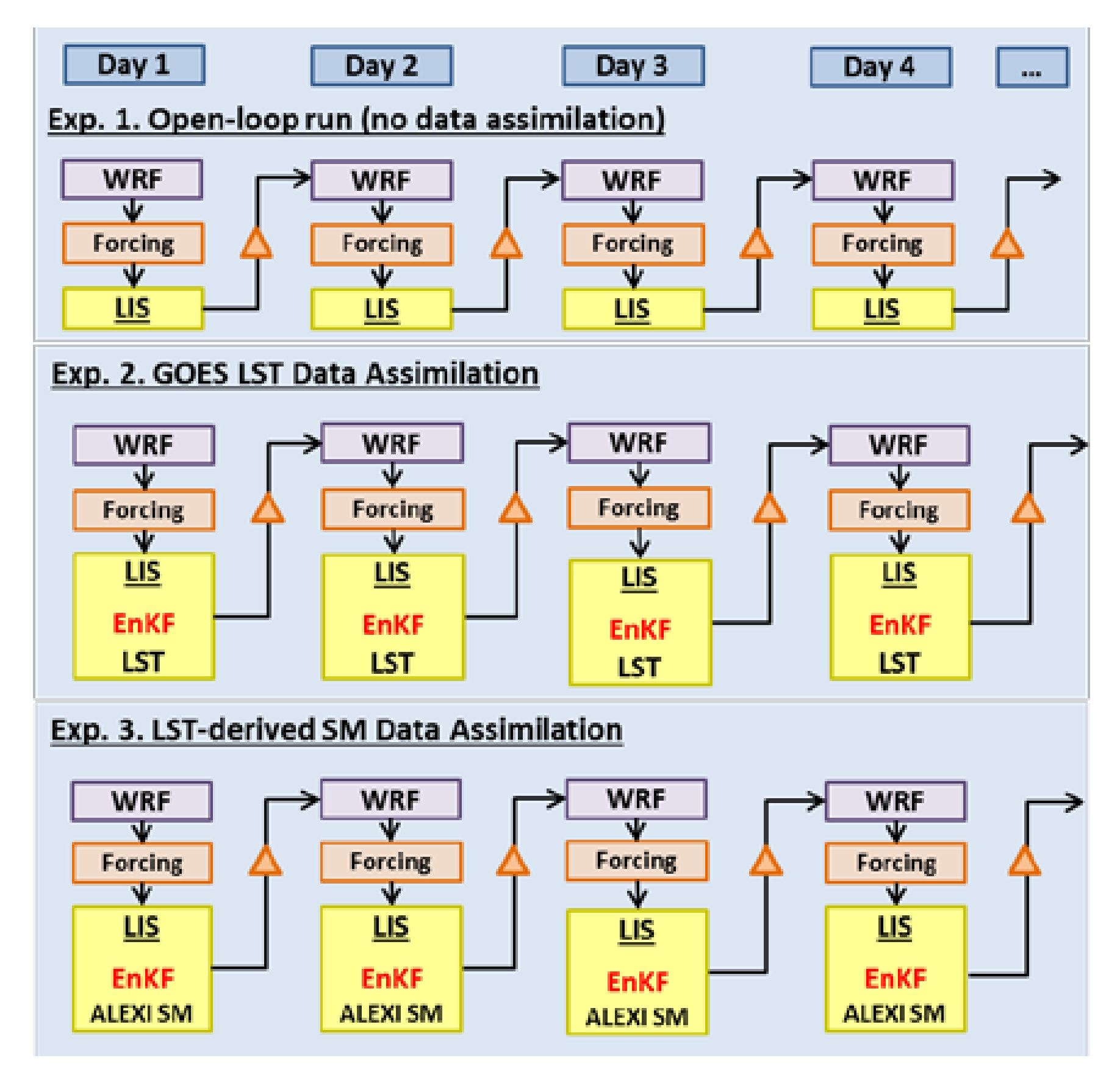
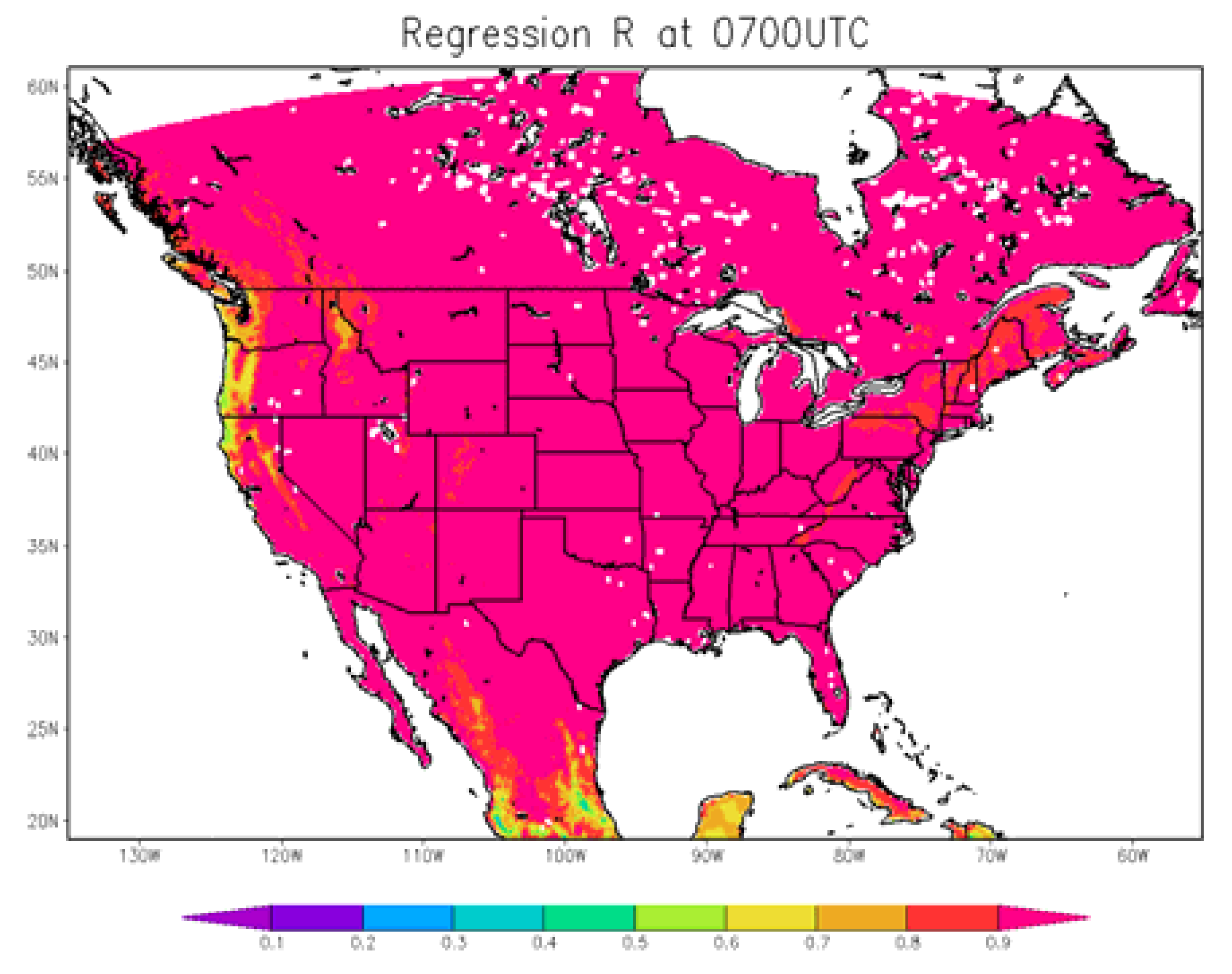
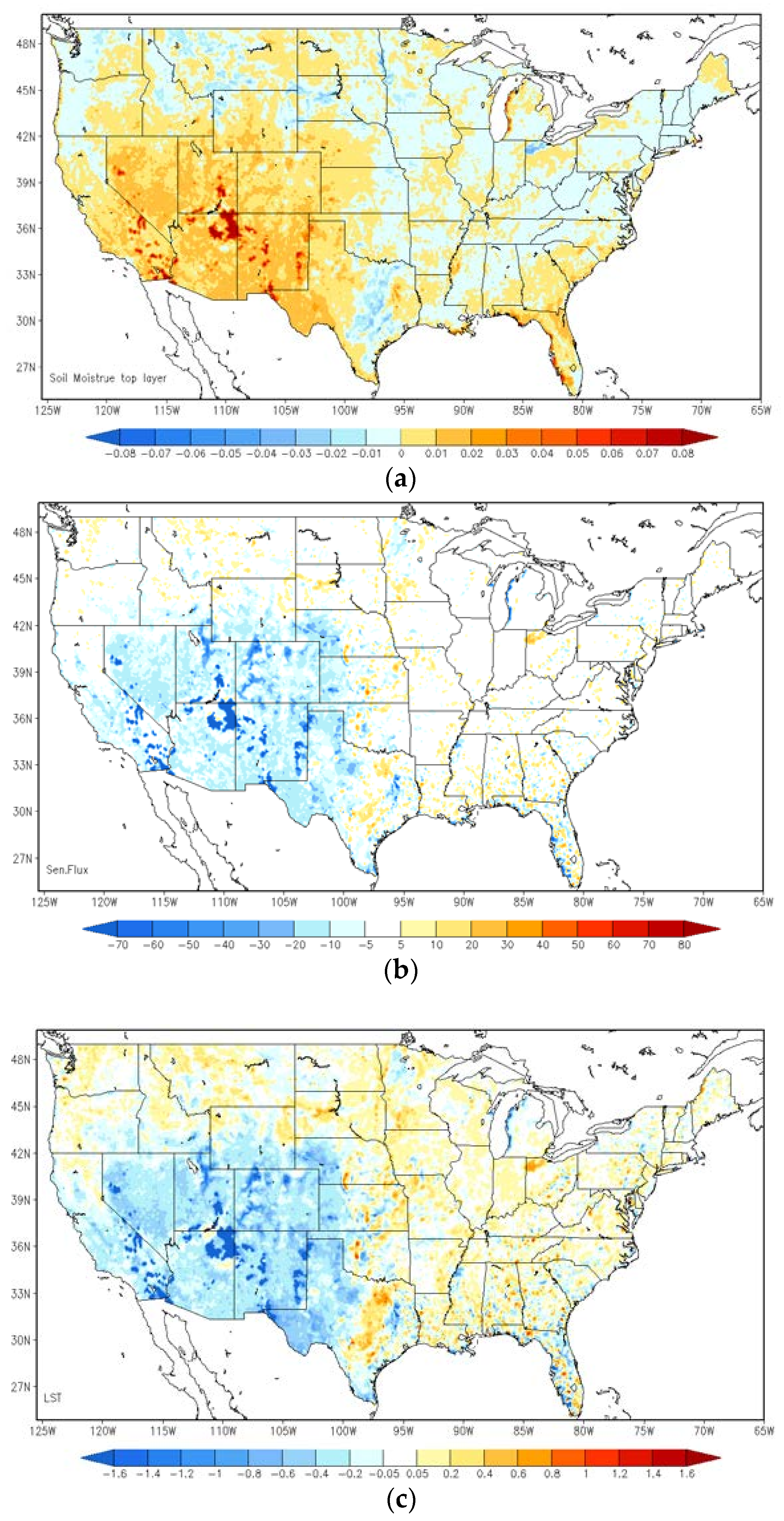
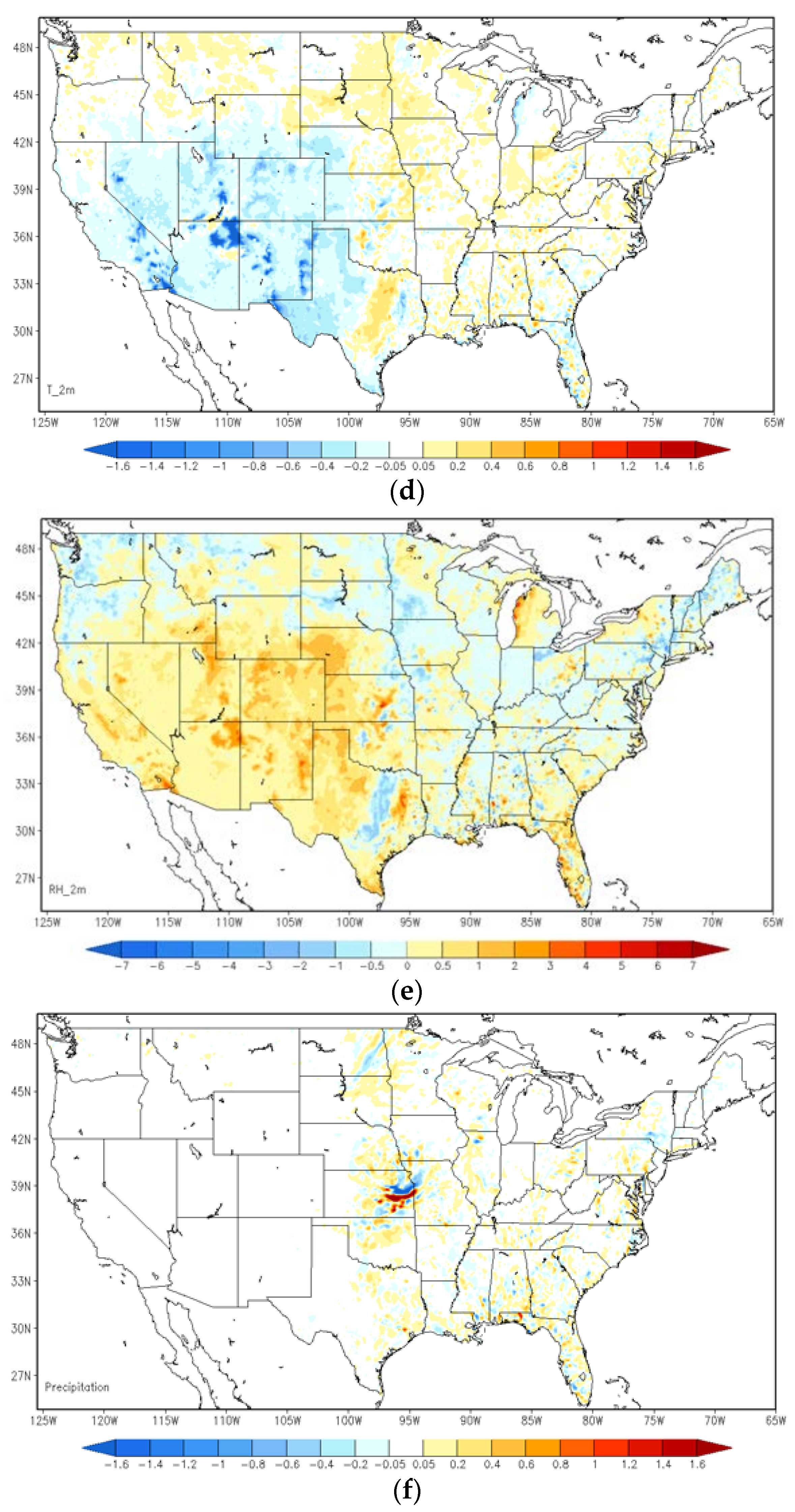
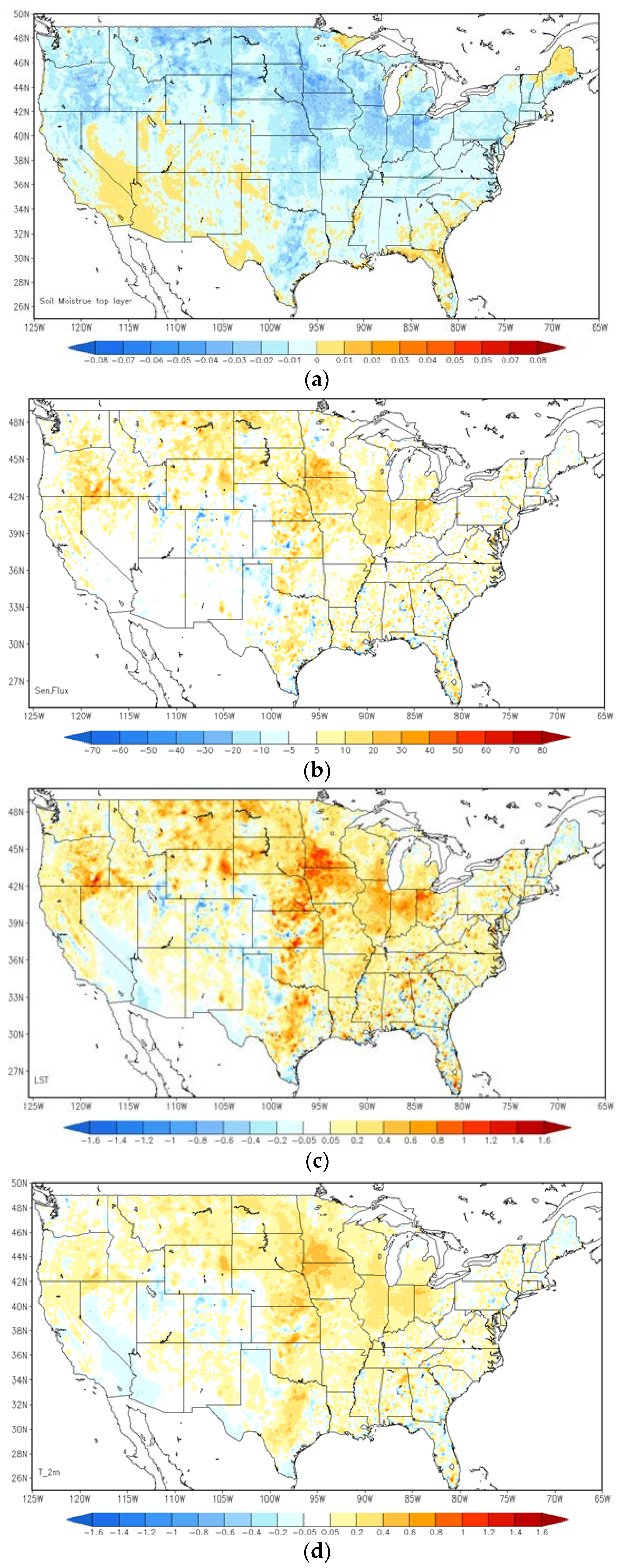

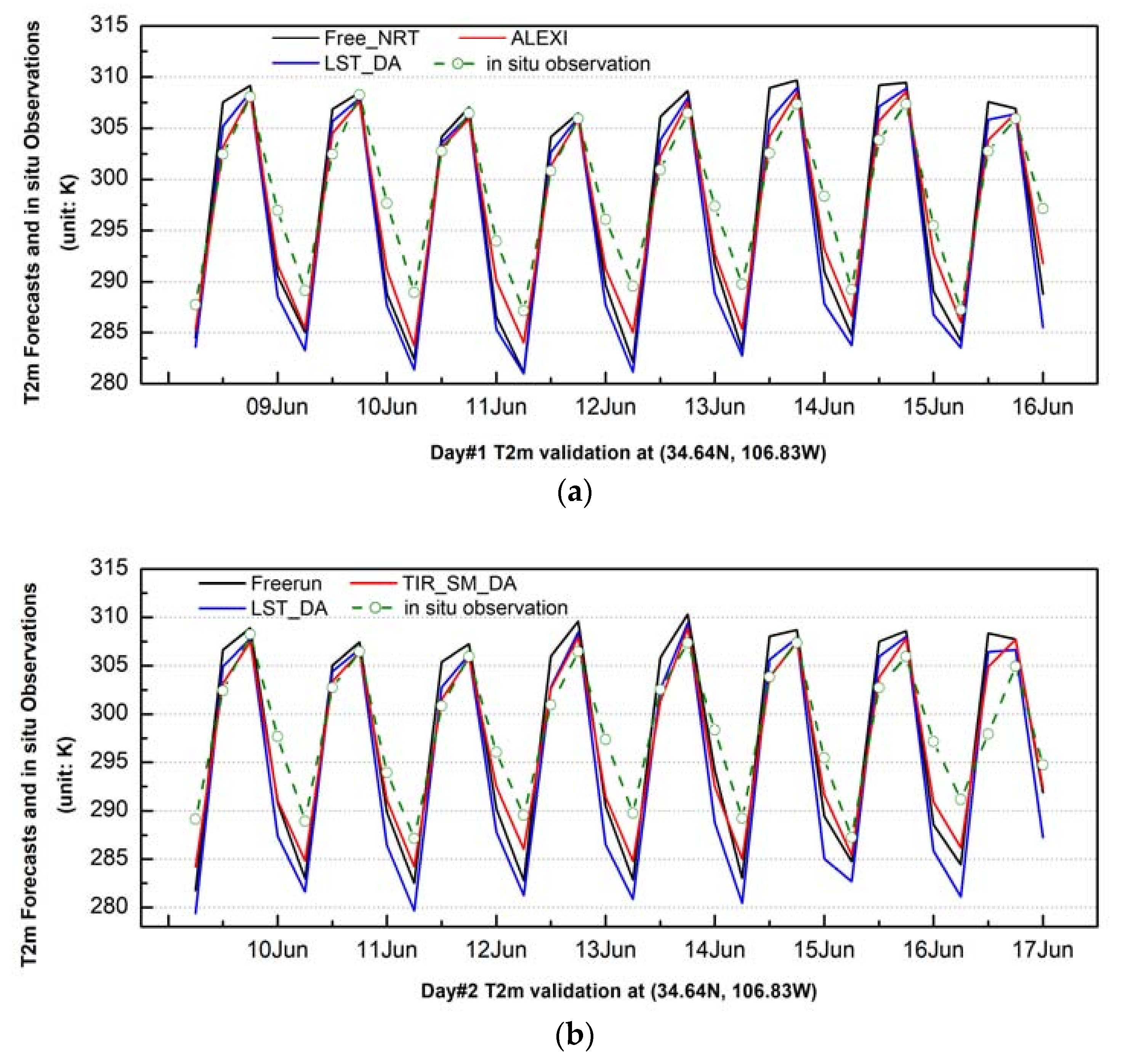
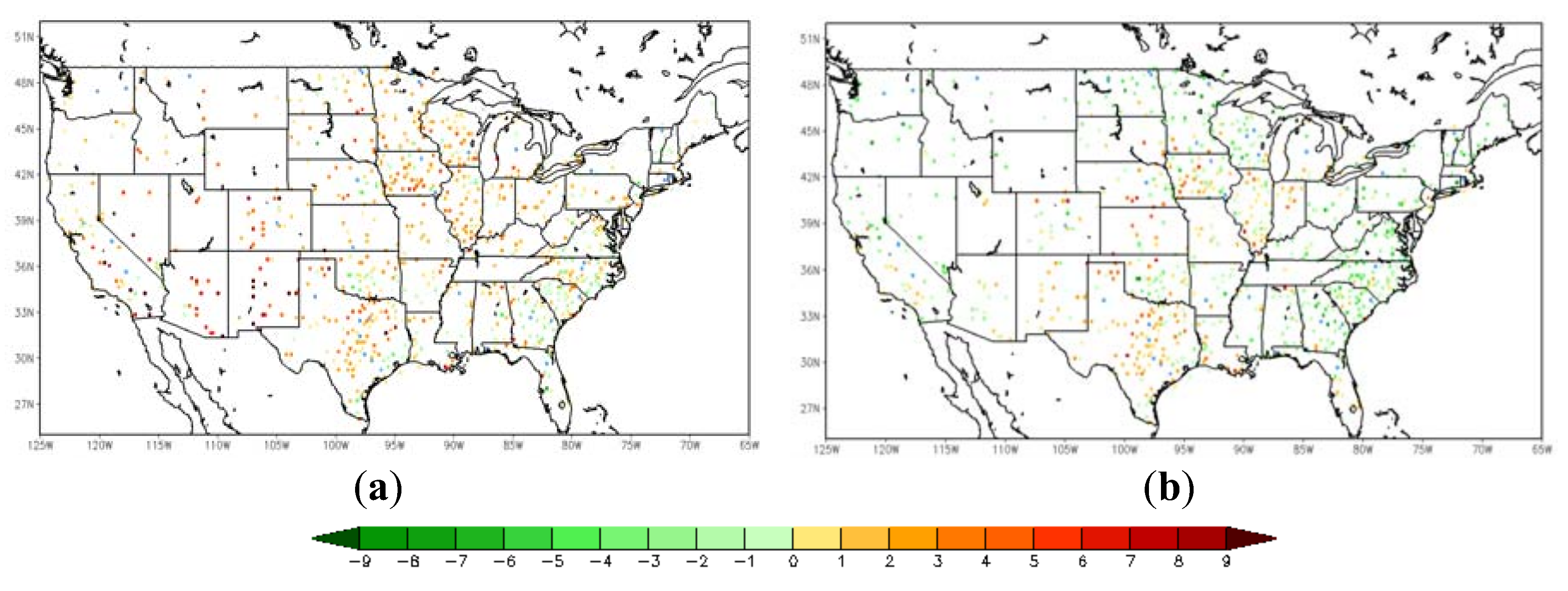
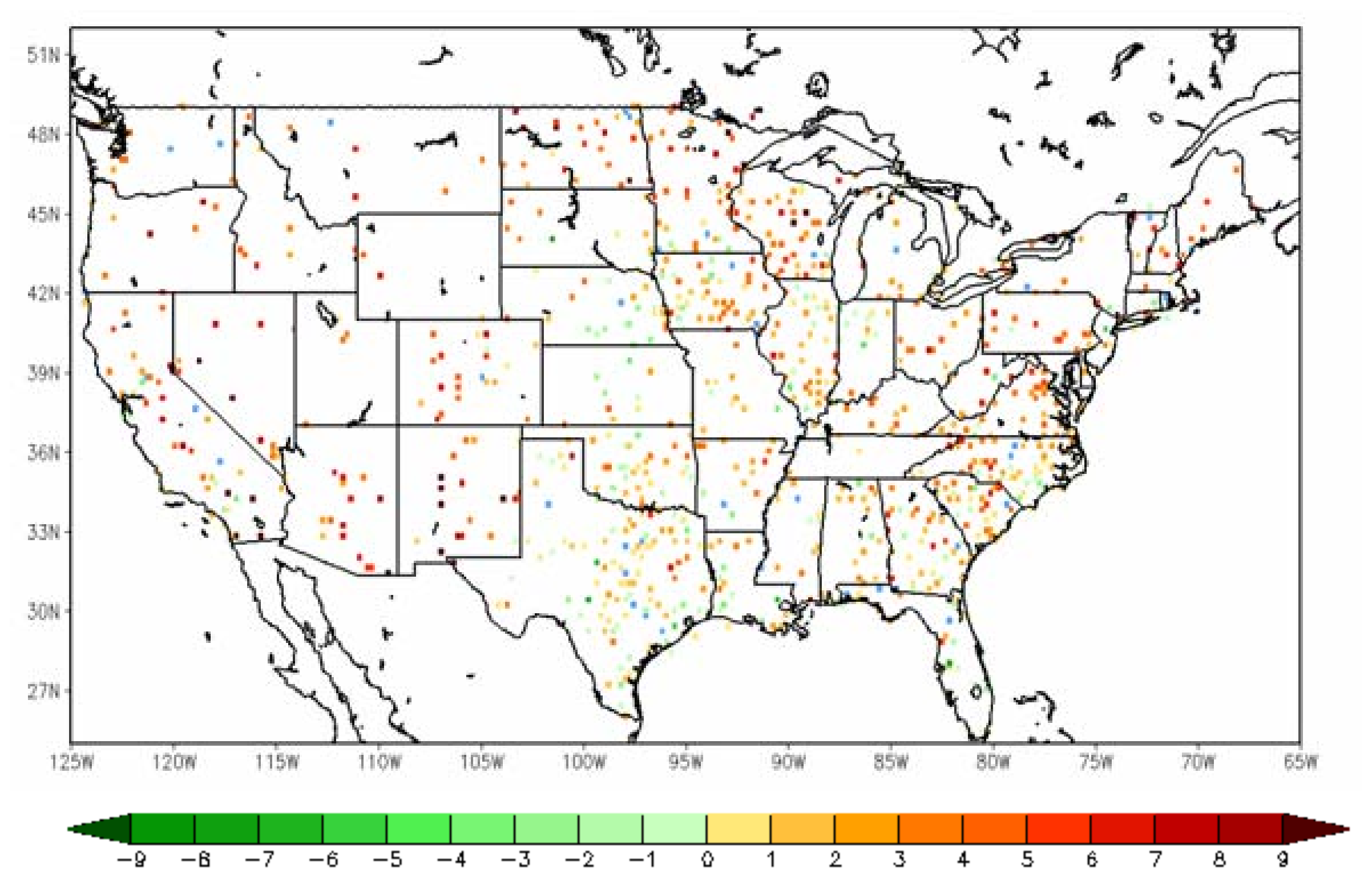
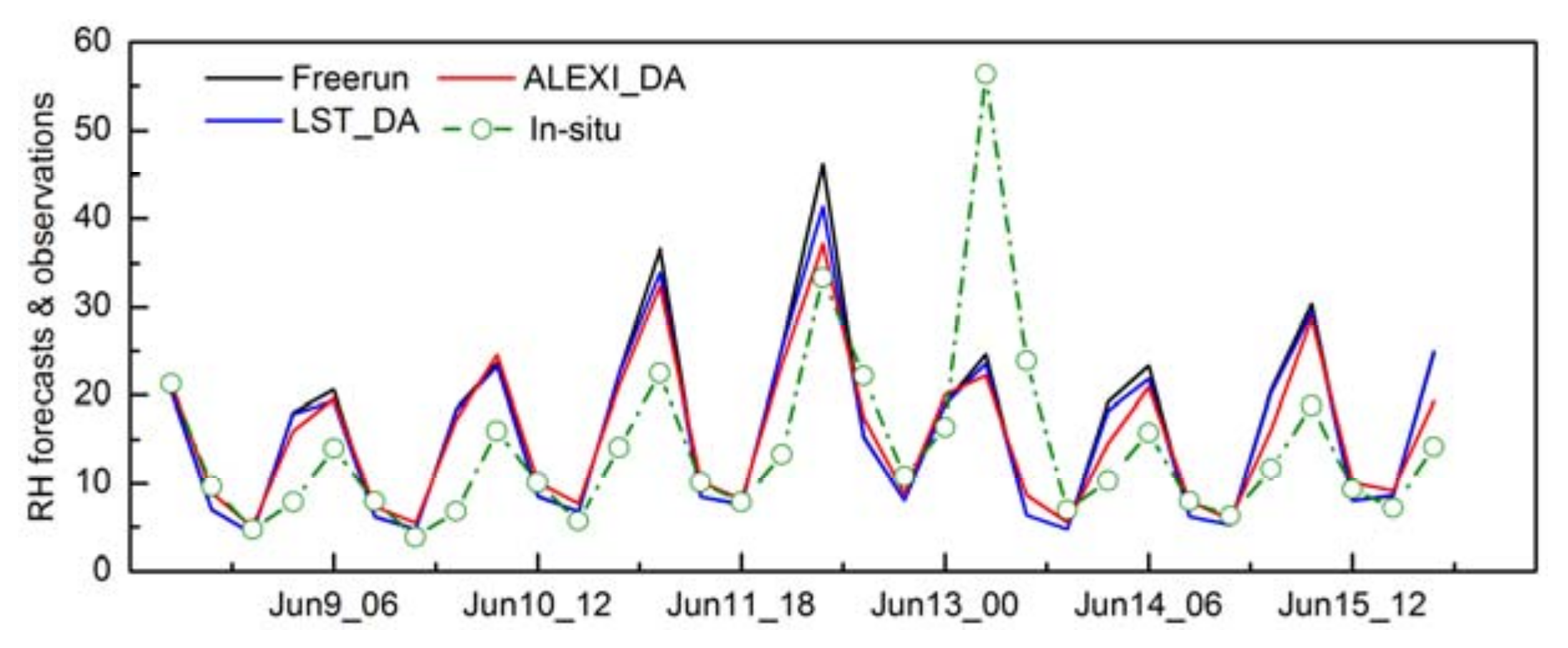
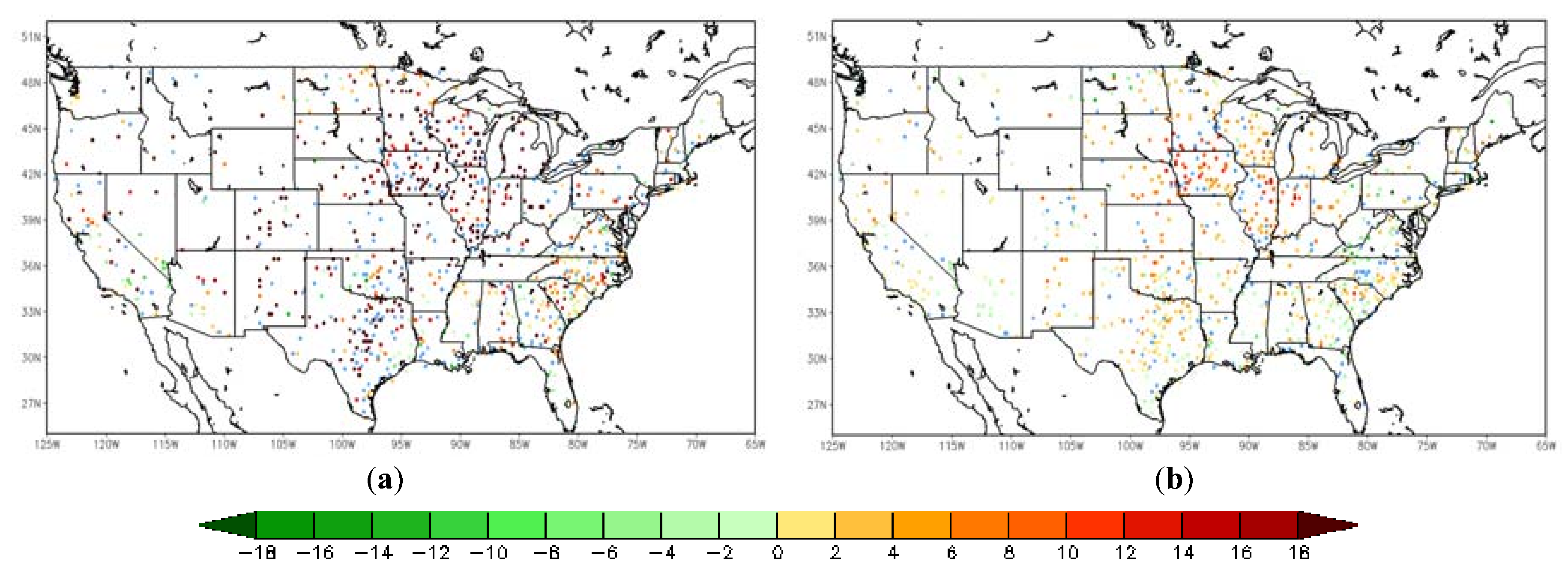
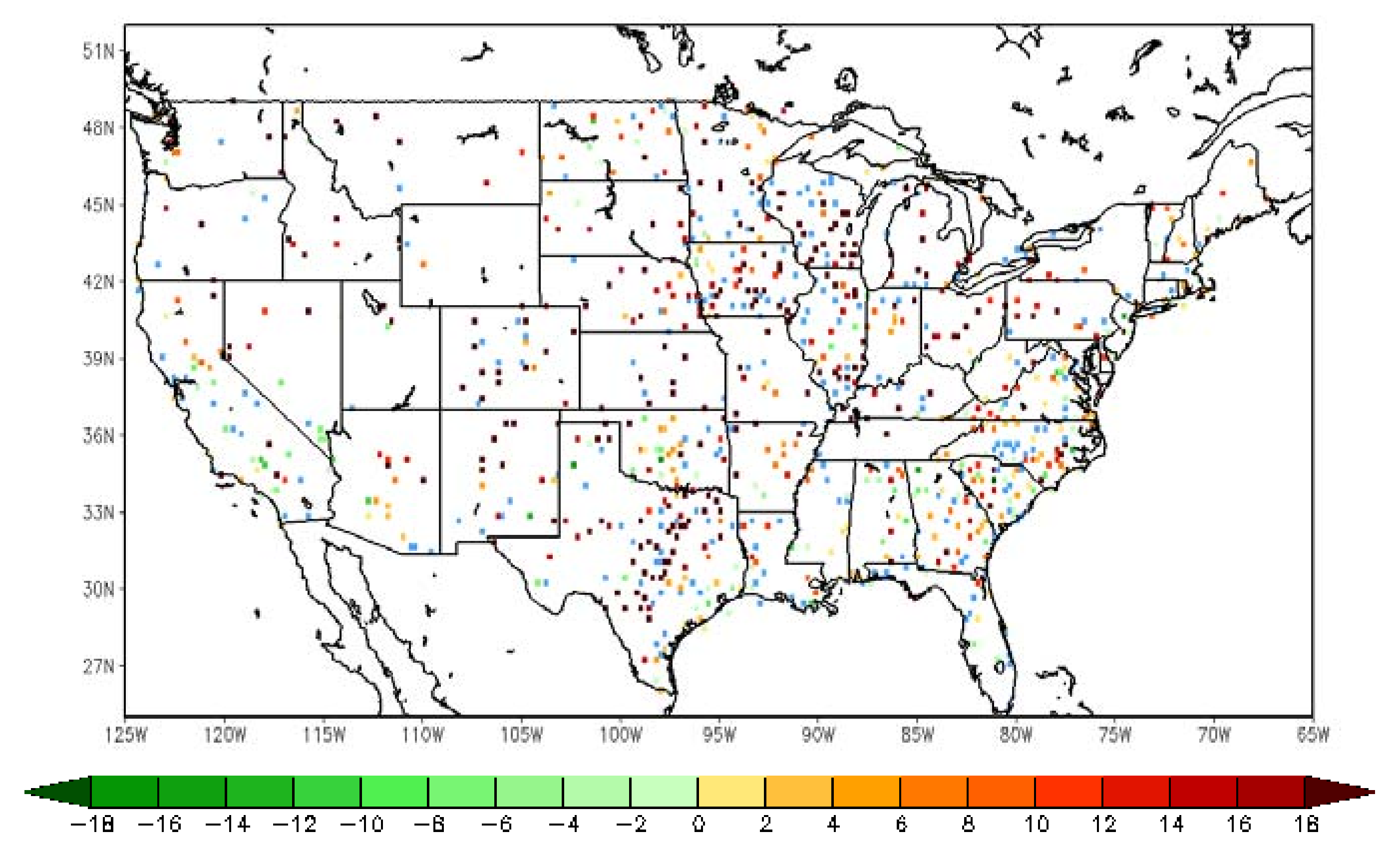

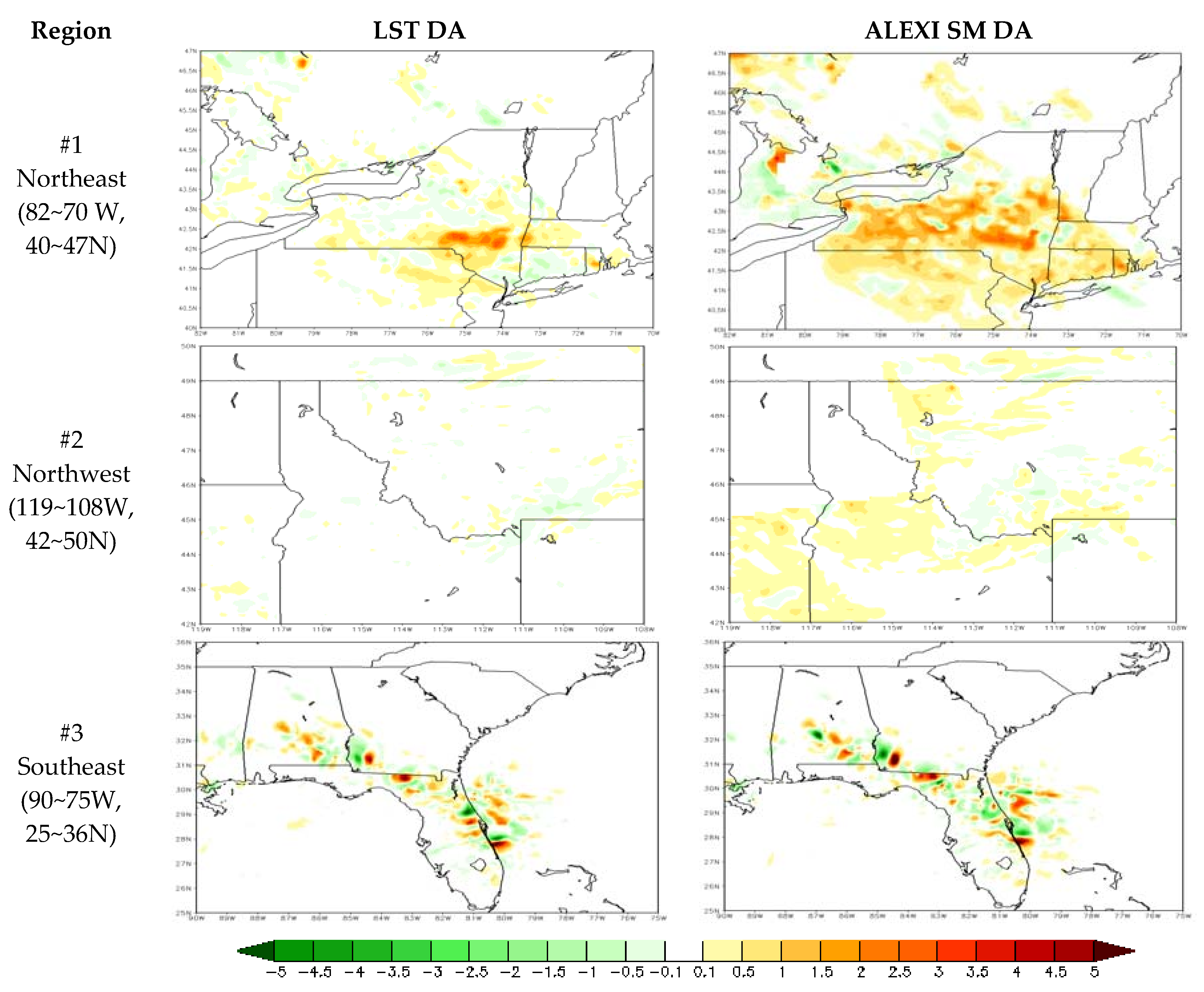
| Variables | Assignment |
|---|---|
| WRF dynamical core | Advanced Research WRF |
| grid spacing/projection | 12 km/Lambert |
| dimension (west-east by south-north) | 480 × 400 |
| Integration time step | 24 s (the same in LIS and ARW) |
| Vertical dimension | 42 |
| number of soil levels or layers | 4 |
| Land usage | MODIS (20-category) |
| Microphysics | 5 (Eta microphysics: the operational microphysics in NCEP models) |
| Land surface | Noah (v3.3) |
| Planetary boundary layer | Mellor–Yamada–Janjic scheme |
| Forecasts | Approaches | Difference in Normalized RMSE * Compared to Open-Loop Run (Percentage) | Number of Sites with Improvements Compared to Open-Loop Run (Percentage) | ||
|---|---|---|---|---|---|
| TX-NM Region | CONUS | TX-NM Region | CONUS | ||
| T-2m | TIR SM DA | 2.65 | 1.58 | 79.58 | 72.29 |
| LST DA | 0.68 | −0.97 | 61.26 | 36.09 | |
| RH-2m | TIR SM DA | 16.22 | 13.10 | 82.72 | 80.45 |
| LST DA | 1.82 | 1.68 | 74.87 | 69.07 | |
| Forecasts | Approaches | Difference in Hit rate ** Compared to Open-Loop Run | Difference In RMSE Compared To Open-Loop Run | ||
| Precipitation | TIR SM DA | 0.16 | 0.18 | ||
| LST DA | 0.08 | 0.04 | |||
© 2018 by the authors. Licensee MDPI, Basel, Switzerland. This article is an open access article distributed under the terms and conditions of the Creative Commons Attribution (CC BY) license (http://creativecommons.org/licenses/by/4.0/).
Share and Cite
Fang, L.; Zhan, X.; Hain, C.R.; Yin, J.; Liu, J.; Schull, M.A. An Assessment of the Impact of Land Thermal Infrared Observation on Regional Weather Forecasts Using Two Different Data Assimilation Approaches. Remote Sens. 2018, 10, 625. https://doi.org/10.3390/rs10040625
Fang L, Zhan X, Hain CR, Yin J, Liu J, Schull MA. An Assessment of the Impact of Land Thermal Infrared Observation on Regional Weather Forecasts Using Two Different Data Assimilation Approaches. Remote Sensing. 2018; 10(4):625. https://doi.org/10.3390/rs10040625
Chicago/Turabian StyleFang, Li, Xiwu Zhan, Christopher R. Hain, Jifu Yin, Jicheng Liu, and Mitchell A. Schull. 2018. "An Assessment of the Impact of Land Thermal Infrared Observation on Regional Weather Forecasts Using Two Different Data Assimilation Approaches" Remote Sensing 10, no. 4: 625. https://doi.org/10.3390/rs10040625
APA StyleFang, L., Zhan, X., Hain, C. R., Yin, J., Liu, J., & Schull, M. A. (2018). An Assessment of the Impact of Land Thermal Infrared Observation on Regional Weather Forecasts Using Two Different Data Assimilation Approaches. Remote Sensing, 10(4), 625. https://doi.org/10.3390/rs10040625






